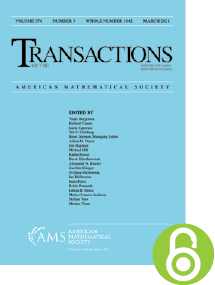Closed hulls in infinite symmetric groups
HTML articles powered by AMS MathViewer
- by Franklin Haimo PDF
- Trans. Amer. Math. Soc. 180 (1973), 475-484 Request permission
Abstract:
Let $\operatorname {Sym} M$ be the symmetric group of an infinite set $M$. What is the smallest subgroup of $\operatorname {Sym} M$ containing a given element if the subgroup is subject to the further condition that it is also the automorphism group of some finitary algebra on $M$? The structures of such closed hulls are related to the disjoint-cycle decompositions of the given elements. If the closed hull is not just the cyclic subgroup on the given element then it is nonminimal as a closed hull and is represented as a subdirect product of finite cyclic groups as well as by a quotient group of a group of infinite sequences. We determine the conditions under which it has a nontrivial primary component for a given prime $p$ and show that such components must be bounded abelian groups.References
-
L. E. Dickson, History of the theory of numbers. Vol. II, Carnegie Inst., Washington, D. C., 1920.
- Matthew Gould, Automorphism groups of algebras of finite type, Canadian J. Math. 24 (1972), 1065–1069. MR 311547, DOI 10.4153/CJM-1972-109-0
- Bjarni Jónsson, Algebraic structures with prescribed automorphism groups, Colloq. Math. 19 (1968), 1–4. MR 223288, DOI 10.4064/cm-19-1-1-4
- Bjarni Jónsson, Topics in universal algebra, Lecture Notes in Mathematics, Vol. 250, Springer-Verlag, Berlin-New York, 1972. MR 0345895, DOI 10.1007/BFb0058648
- A. Karrass and D. Solitar, Some remarks on the infinite symmetric groups, Math. Z. 66 (1956), 64–69. MR 81274, DOI 10.1007/BF01186596 T.-J. Stieltjes, Essai sur la théorie des nombres; premiers élements, Paris, 1895. H. Wielandt, Unendliche Permutationsgruppen, Zweite Vervielfältigung, York University, 1967.
Additional Information
- © Copyright 1973 American Mathematical Society
- Journal: Trans. Amer. Math. Soc. 180 (1973), 475-484
- MSC: Primary 20E99
- DOI: https://doi.org/10.1090/S0002-9947-1973-0322065-6
- MathSciNet review: 0322065


